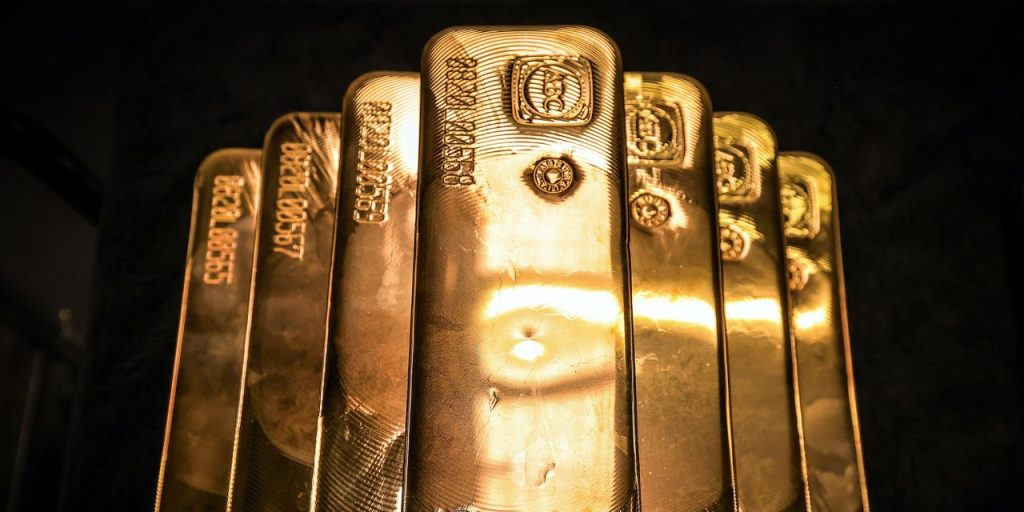Gold futures settled off the session’s highs on Friday, but held onto a gain for the week, with investors taking a “wait and see” approach in terms of the Federal Reserve’s path for interest rates, despite monthly data showing a slowdown in U.S. job gains.
Price action
-
Gold for December delivery
GC00,
+0.30% GCZ23,
+0.30%
rose $1.20, or nearly 0.1%, to $1,967.10 an ounce on Comex after trading as high as $1,980.20. For the week, prices were 1.4% higher after posting an August loss of more than 2%. -
December silver
SIZ23,
+0.87%
declined by 25 cents, or 1%, at $24.56 an ounce, settling nearly 1/4% higher for the week. -
December copper
HGZ23,
+1.70%
ended at $3.85 a pound, up 0.8% for the session and logging a weekly gain of 2.4%. -
October platinum
PLV23,
+0.53%
shed 0.6% to $968.70 an ounce, with prices up 2.2% for the week, and December palladium
PAZ23,
+1.19%
edged up by 0.7% to $1,227.40 an ounce, for a weekly fall of 0.1%.
Market drivers
Much-anticipated data from the Labor Department revealed that the U.S. economy added 187,000 jobs in August. That came in above economist expectations for a gain of 170,000, but still showed a slowdown in the pace of job gains. The unemployment rate climbed to 3.8% from 3.5% in July.
“When you have a cooling in jobs data, combined with the expectation that the Fed will reconsider another rate hike this month, you’d expect gold prices to rise,” said Adam Koos, president at Libertas Wealth Management Group.
“However, this same fundamental data is causing a pullback in bonds and a spike in Treasury yields, which is creating a tug-of-war between gold and the ancillary players that affect prices,” he told MarketWatch.
Gold futures saw a modest gain, settling well below the session’s high of more than $1,980.
The U.S. dollar strengthened in Friday’s dealings, with the ICE U.S. Dollar index
DXY
up 0.5% at 104.17 and the 10-year treasury yield
BX:TMUBMUSD10Y
moving to 4.18% from 4.09% on Thursday afternoon.
The gold market is seeing a “period of complacency on the part of investors as we’ve entered a period of ‘wait and see’,” said Koos. “Traders want to know what the Fed is going to do, first and foremost. ”
From there, “all eyes are going to be on yields,” he said. “Since inflation has become less of a factor lately, the U.S. dollar will be the other player in focus, as we should start to see some directional movement — up or down — since it’s gone through its own, nine- to 10-month consolidation.”
That said, “if inflation remains moot and the momentum in yields start to cool down, it’ll be the U.S. dollar that’ll likely be the catalyst that keeps the yellow metal in its cage, below 52-week and multi-year highs, or all-time highs by year-end,” Koos said.
In terms of the jobs data, Jeff Klearman, portfolio manager at GraniteShares, which runs the GraniteShares Gold Trust BAR, told MarketWatch that the figures should have added to “Fed-pause-pivot expectations, pulling Treasury rates and the U.S. dollar lower, both factors which could push gold prices higher over time.”
However, he also said the “slightly higher-than-expected wage growth may act to somewhat offset the impetus provided by the lower-than-expected headline jobs created number.”
The increase in pay over the past year fell a tick to 4.3%. Fed officials want to see wage growth slow to pre-pandemic levels of 3% or less.
Gold prices finished higher for the week, with that strength “mainly the result of slightly weaker-than-expected economic data released over the last couple of weeks,” said Klearman.
“Tuesday’s weaker-than-expected consumer confidence release and the JOLTS report, combined with Wednesday’s revised-lower GDP release, helped increase expectations of a Fed pause through the end of year, pushing 10-year Treasury rates and the U.S. dollar off their recent highs and, as a result, [buoyed] gold prices,” he said.” More of the same occurred with an as-expected PCE Price Index release Thursday showing inflation — measured month over month — is near Fed-targeted levels.”
Read the full article here















